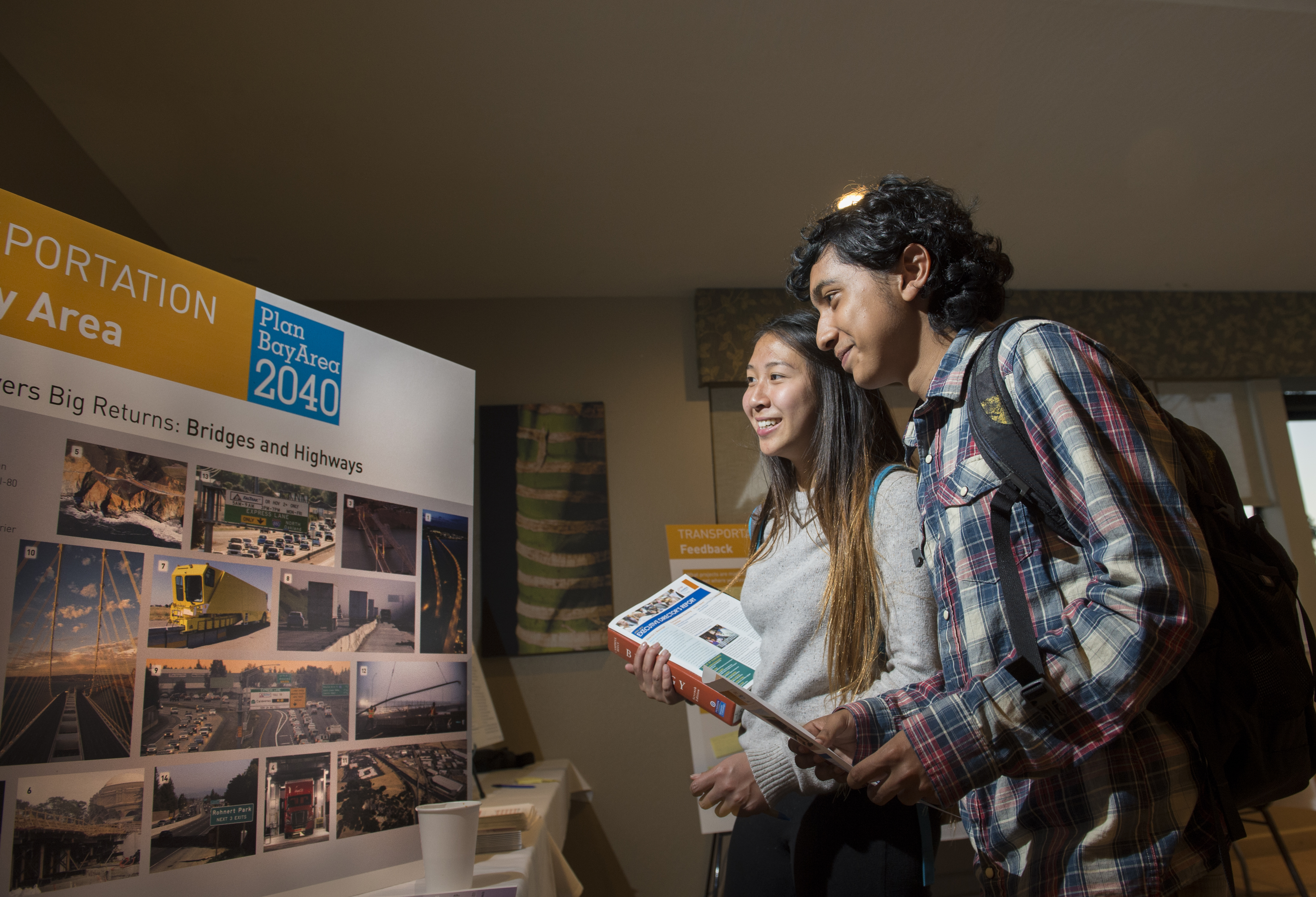Plan Bay Area 2040 Final Plan
Final Plan Bay Area 2040
Plan Bay Area 2040 Final Plan
Final Plan Bay Area 2040
What is Plan Bay Area 2040?
 go to previous page
go to next page
go to previous page
go to next page
Plan Bay Area 2040 is a state-mandated, integrated long-range transportation and land use plan. As required by Senate Bill 375, all metropolitan regions in California must complete a Sustainable Communities Strategy (SCS) as part of a Regional Transportation Plan. In the Bay Area, the Metropolitan Transportation Commission (MTC) and the Association of Bay Area Governments (ABAG) are jointly responsible for developing and adopting a SCS that integrates transportation, land use and housing to meet greenhouse gas reduction targets set by the California Air Resources Board (CARB).
The region adopted its previous plan — Plan Bay Area — in July 2013. As the Bay Area’s first regional transportation plan to include a Sustainable Communities Strategy, the original Plan Bay Area charted a course for reducing per-capita greenhouse gas emissions through the promotion of more compact, mixed-use residential and commercial neighborhoods near transit. Plan Bay Area supported Priority Development Areas (PDAs) selected and approved by city and county governments with planning grants, technical assistance, and prioritization for regional and state transportation and affordable housing funds.
Plan Bay Area 2040 is a limited and focused update that builds upon the growth pattern and strategies developed in the original Plan Bay Area but with updated planning assumptions that incorporate key economic, demographic and financial trends from the last four years.
The Metropolitan Transportation Commission (MTC) is the transportation planning, financing and coordinating agency for the nine-county San Francisco Bay Area. MTC is the federally designated Metropolitan Planning Organization and the state designated Regional Transportation Planning Agency for the region. MTC is responsible for preparing and updating a long-range regional transportation plan every four years that identifies the strategies and investments needed to maintain, manage and improve the region’s transportation network.
The Association of Bay Area Governments (ABAG) serves as the Council of Governments for the region. As required by state law, ABAG updates the Regional Housing Need Allocation (RHNA) every eight years, allocates specific housing targets to individual cities and counties, and develops the regional forecast of jobs, population and housing. MTC and ABAG recently consolidated their staffs to more effectively and efficiently develop an integrated long-range transportation and land use plan.
Plan Bay Area 2040 provides a roadmap for accommodating projected household and employment growth in the nine-county Bay Area by 2040 as well as a transportation investment strategy for the region. Plan Bay Area 2040 details how the Bay Area can make progress toward the region’s long-range transportation and land use goals.
Plan Bay Area 2040:
Describes where and how the region can accommodate 820,000 new projected households and 1.3 million new jobs between now and 2040;
Details a regional transportation investment strategy given $303 billion in expected revenues from federal, state, regional and local sources over the next 24 years;
Complies with Senate Bill 375, the state’s sustainable communities strategy law, which integrates land use and transportation planning and mandates both a reduction in greenhouse gas emissions from passenger vehicles and the provision of adequate housing for the region’s 24-year projected population growth.
Plan Bay Area 2040 encompasses the entire Bay Area, including the nine counties and the 101 cities and towns that make up the region. The plan is constrained by the amount of expected transportation revenues and expected household and employment growth.
Plan Bay Area 2040 neither funds specific transportation projects nor changes local land use policies. Importantly, individual jurisdictions retain all local land use authority. But Plan Bay Area 2040 does set a roadmap for future transportation investments and identifies what it would take to accommodate expected growth.
Plan Bay Area 2040 establishes a vision for the Bay Area that closely aligns with the broad goals of the state of California. The plan’s goals to promote economic vitality, ensure social equity and protect the environment link to the policy framework established in California Transportation Plan 2040 by the California Department of Transportation. Central to both plans are carbon dioxide (CO2) emissions reduction targets designed to tackle climate change in the years to come. Similarly, both plans prioritize fixing an aging transportation system, focusing future growth and directing increased funding toward non-auto modes of travel. Both multiyear planning efforts reflect a relatively consistent vision for moving forward for the region’s 8 million people and the state’s 39 million people. The key to implementation will be working together across local, regional, state and federal levels to achieve these shared goals.
The Bay Area Air Quality Management District (Air District) is the region’s air pollution control agency. In April 2017, the Air District adopted the 2017 Clean Air Plan, which provides a regional strategy to protect public health and the climate. The Clean Air Plan describes how the region will continue progress toward attaining all state and federal air quality standards and eliminating health risk disparities from exposure to air pollution. The Clean Air Plan further defines a vision and a regional climate protection strategy for transitioning to a post-carbon economy and achieving ambitious greenhouse gas reduction targets for 2030 and 2050. While Plan Bay Area 2040 has a requirement to reduce per-capita CO2 emissions from passenger vehicles by 2035, the Air District’s plan addresses a much wider range of pollutants from a much larger number of sources. To that end, Plan Bay Area 2040 is “one piece of the puzzle.” Additional policies and investments beyond Plan Bay Area 2040 are needed to meet the Air District’s more ambitious targets.
Developing a multibillion dollar plan for the region is no simple task. It is a multiyear process involving four regional agencies, nine counties, 101 towns and cities, elected officials, transit operators, planners, community-based organizations, business organizations, non-profits and the general public.
Despite this complexity, public participation is critical to an open process in which all interested residents have the opportunity to provide input and share their vision for what the Bay Area should look like decades from now. Highlights from Plan Bay Area 2040’s public participation process included over 190 public meetings, of which 27 were open houses (three in each of the nine Bay Area counties); partnerships with five community organizations working in low-income communities and communities of color; public hearings on the draft plan and its environmental impact report; a robust online presence; numerous meetings with local elected officials, planning directors and transportation officials; two summits with Native American tribal leaders; a housing forum; and a telephone poll of some 2,040 Bay Area residents.
For more information on Plan Bay Area 2040’s outreach and engagement process, please see the Public Engagement Program Report and the Native American Tribal Outreach Report .

Public meetings were held in all nine counties to discuss the plan’s development.
Credit: Karl Nielsen
Public meetings were held in all nine counties to discuss the plan’s development.
Credit: Karl Nielsen

Public meetings were held in all nine counties to discuss the plan’s development.
Credit: Karl Nielsen
After receiving feedback from stakeholders and the public, MTC and the ABAG Executive Board established seven goals and 13 performance targets to measure Plan Bay Area 2040’s effectiveness in addressing the major challenges facing the region.
Senate Bill 375 mandates two of these targets. First, Plan Bay Area 2040 must address climate change by reducing per-capita CO2 emissions from cars and light-duty trucks. Second, Plan Bay Area 2040 must include sufficient housing for all of the region’s projected population growth, regardless of income.
TABLE 2.1 Final adopted goals and performance targets for Plan Bay Area 2040.
Plan Bay Area 2040 includes seven goals and 13 performance targets covering three broad areas: the environment, equity and the economy. These aggressive and aspirational targets enable the plan to be evaluated by its performance in areas identified
as key regional concerns, including equitable access, economic vitality and transportation system effectiveness. The performance targets were the result of a robust public process and reflect MTC and ABAG’s commitment to go beyond Plan Bay Area
2040’s legal requirements.
Source: Metropolitan Transportation Commission - Resolution No. 4204, Revised, 2015
MTC and the ABAG Executive Board voluntarily adopted 11 additional targets as shown in Table 2.1. Key goals for Plan Bay Area 2040 included tackling the Bay Area’s inequities through improved affordability and lessened displacement risk, ensuring a robust economy, and protecting the environment for future generations. These targets are aggressive and some are quite aspirational. Yet they reflect MTC and ABAG’s commitment to take a more holistic view of the possibilities of integrated regional planning by going beyond the plan’s legal requirements.
For more information on the development of Plan Bay Area 2040’s performance targets, please see the Performance Assessment Report .
The next section, Forecasting the Future, will review the primary inputs to Plan Bay Area 2040.